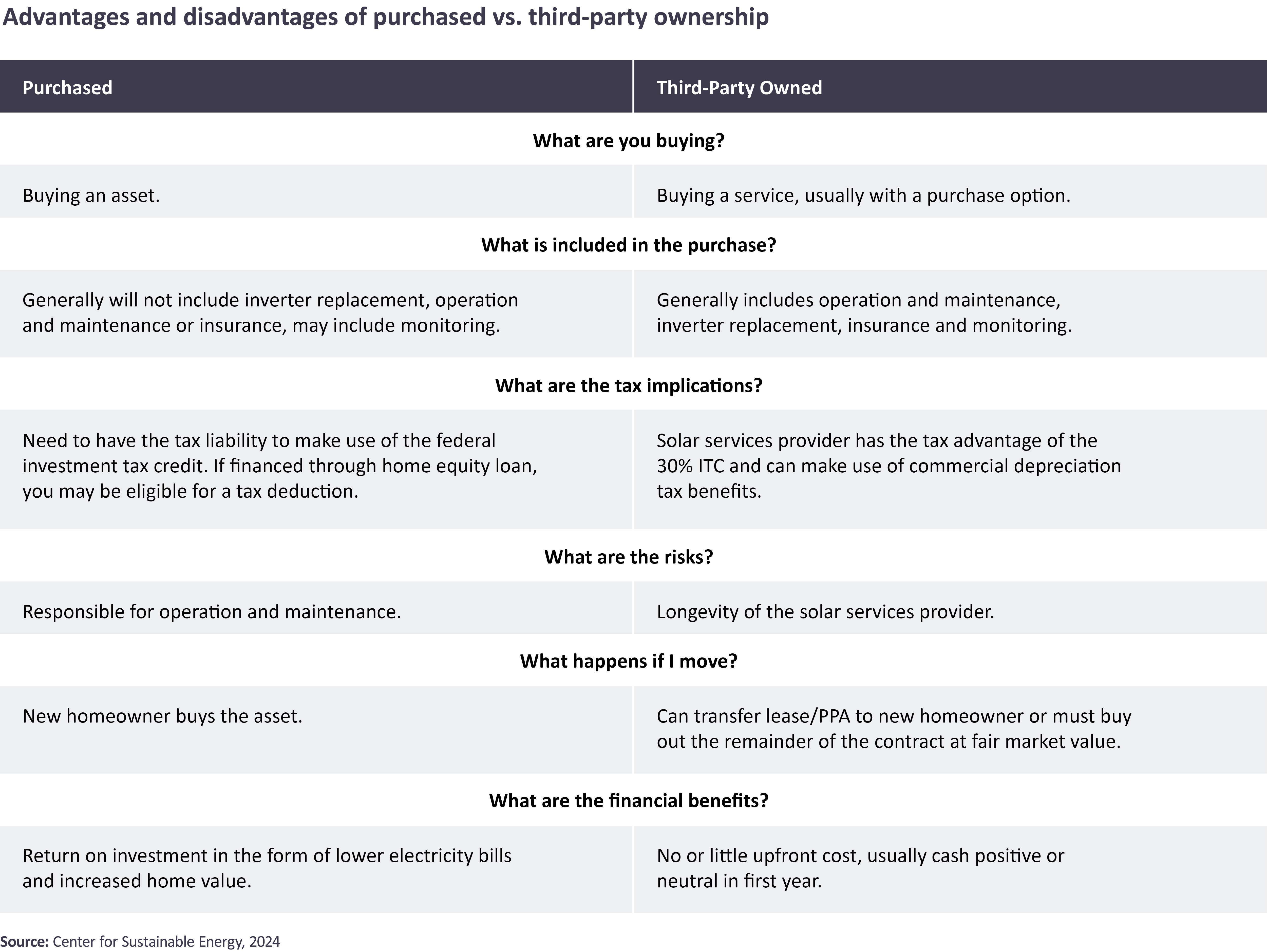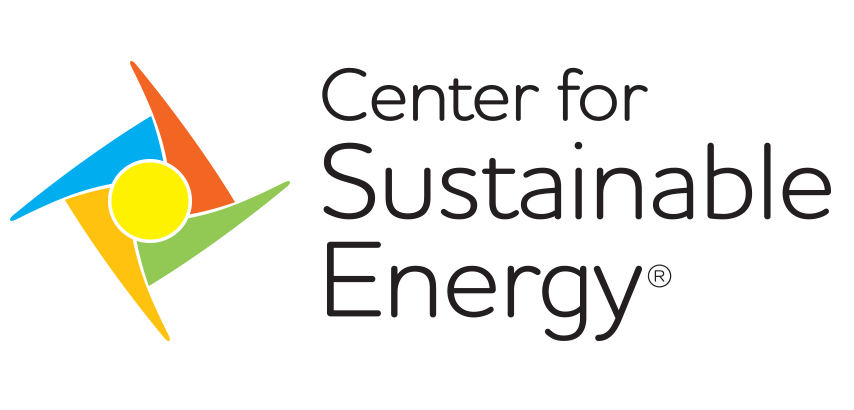Solar Energy Adoption: Information for Homeowners and Small Businesses

Sunlight can power everything in your home or business, from lights and appliances to heavy equipment and electric vehicles. Installing a solar photovoltaic (PV) system reduces your fossil fuel use, cuts greenhouse gas emissions, increases your energy independence and can lower your energy bills.
The Center for Sustainable Energy (CSE), a nonprofit that designs and administers state, local and utility clean energy incentive programs across the nation, answers some frequently asked questions about solar.
Four Benefits of Solar Panels
1. Save money on your utility bill.
With electricity rates rising nationwide, solar can reduce your grid energy use and save you money on your monthly bill.
2. Reduce harmful emissions.
Solar energy is a renewable, zero-emission energy source that reduces your carbon footprint and helps fight climate change.
3. Increase your property’s value and appeal.
Studies show homes with solar energy systems typically sell for more than comparable homes without solar.
4. Increase resilience and cost savings when coupled with battery storage.
Stored solar energy can be used during power outages and at times of peak demand when grid electricity rates are the highest.
System Costs & Incentives
The cost of installing solar depends on your home, location and the programs available to you.
How much do photovoltaic systems cost?
The price of a photovoltaic system is based on numerous factors, including system components and configuration, difficulty of installation and available incentives. The national average installed cost for a residential solar electric system is approximately $3.36/watt. That means the average 7-kilowatt (kW) residential system will cost about $23,500. With the federal Residential Clean Energy Credit (known as the Investment Tax Credit) unavailable after Dec. 31, 2025, state and local programs will become the primary sources of incentives. To find incentives specific to your location, check the Data Base of State Incentives for Renewables & Efficiency (DSIRE). You can also contact your state's energy department or a local solar installer.
What is the average payback period?
The average payback period for an owned residential solar electric system, without the federal tax credit, is around 10 years, depending on the weather conditions where you live, the cost of the system and the utility bill savings. (EnergySage, 2025)
The impact of energy bill savings can be especially significant for low-income households, which typically spend a higher percentage of their income on energy costs.
What are the available incentives?
Even without the federal Residential Clean Energy Credit, many state and local incentives continue to make residential solar power a cost-effective investment. These include state and local tax credits, utility rebates, net metering policies and favorable financing options.
Some states also offer incentives for low- and moderate-income households and residents of multifamily housing. In California, the Solar on Multifamily Affordable Housing Program offers substantial rebates.
For detailed information on incentives, visit DSIRE.
What are typical financing options?
You can pay for your home solar PV system with cash or through loans, making you the system owner. Or you can obtain a lease or power purchase agreement (PPA) held by a third-party owner. Each of the following options has different tax, ownership and resale implications—be sure to compare them before signing.
- Home equity loan – Bank loan secured with equity from your house.
- Low-interest energy efficiency and renewable energy loans – Solar loans may be offered by credit unions or banks. They are a secured loan, often with low-interest rates and longer terms.
- Property assessed clean energy (PACE) loans – PACE loans offer financing for green property upgrades, including solar, that are tied to the property, rather than the borrower. (Only available in a few states.)
- Power purchase agreements (PPAs) – PPAs and solar leases are for systems installed on your home but owned by a third party. You either pay a fixed amount per month or a fixed amount per each kWh (kilowatt-hour) the system produces. The terms for PPAs and leases are typically 20 years and are transferred with a property to a new owner.

Net Metering
What is net metering?
Many states have net metering policies that compensate solar owners for sending electricity to the grid when their panels produce more power than the property uses. Typically, the owner receives bill credits, not money, which are “banked” and available when the property uses electricity from the grid.
Net metering and other compensation vary from state to state and among individual utilities. Check your local utility to understand what is available. DSIRE offers a comprehensive list of solar incentives by state, as well as information and maps showing solar policies across the U.S.
System Design
What size system should I install at my home?
Every site is different, and the needs of the system owner vary. System size depends on your home’s energy use, roof orientation and tilt, available space and budget.
You do not have to offset 100% of the consumption of your home or business. Always consult with a licensed installer or contractor to determine the optimal size of your system.
For individual properties, the Department of Energy recommends several online tools to estimate the amount of solar that could be installed on a given rooftop.
How efficient are photovoltaic modules?
Most residential solar panels are 15–23% efficient, meaning they convert that portion of sunlight into electricity. More efficient panels require less space to produce the desired amount of electricity. Over their 20–25-year lifespan, solar panels slowly degrade, losing about 0.5% of their efficiency per year.
Where should I put my panels?
PV panels are typically installed on your roof but also can be mounted on the ground. In the U.S., the ideal direction to have your panels face is south or west to maximize sun exposure. Installers can also design systems to fit east-facing roofs or shaded sites using optimized inverters or microinverters.
Do solar panels and inverters come with a warranty?
PV panels come with a 25-year production warranty. A central inverter comes with a 10-year warranty, while microinverters come with a 25-year warranty. Most central inverter manufacturers offer a supplementary 10-year extended warranty at an additional cost. Ask your contractor for a 10-year workmanship warranty to protect against defects and undue degradation in electrical generation output.
What is the typical solar installation timeline?
Your project will need a building or electrical permit from the appropriate city or county department before your contractor can legally begin installation. Once permits are obtained, a typical residential installation takes as few as one to three days to complete.
Once your system is installed, the city or county will inspect it. After your system passes this inspection, your local utility also may inspect it to ensure a proper connection to the electrical grid and that it meets all safety requirements.
Can I add energy storage batteries with my solar panels?
Yes. A home battery system can store the extra electricity your solar panels produce during the day so you can use it later, like in the evening or during a power outage. This helps you rely less on the electric grid and avoid using costly peak-hour energy. Battery storage can also keep essential devices running if the power goes out, giving your home greater stability. Plus, by making the most of your solar energy, you’ll further reduce your carbon footprint.


